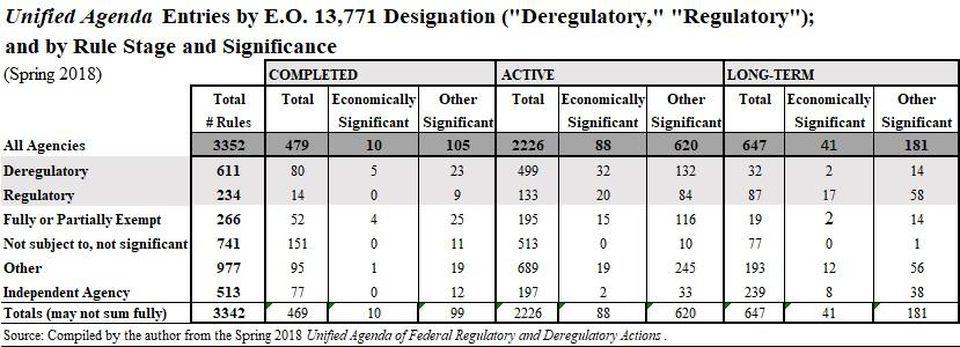Trump’s 2018 Regulatory Reform Agenda by the Numbers
The Trump administration has released the new Spring 2018 edition of the twice-yearly Unified Agenda of Federal Regulatory and Deregulatory Actions.
The Unified Agenda, around since the early 80s, is hardly riveting reading and most people have not heard of it. However, it has long revealed regulatory priorities of the federal bureaucracy, and Trump’s emphasis on regulatory liberalization and reviewing the inventory for cuts is unique.
The administration emphasized that it is on track to meet commitments—basically eliminating at least two significant regulations for every new one added—under Trump’s Executive Order 13771on Reducing Regulation and Controlling Regulatory Costs.
While a dollar amount for cost savings was provided in 2017 of $8 billion (in present value terms) anticipated for that year, and $10 billion in the current 2018 fiscal year, an update on that figure was not provided this week. However, the White House says it is on track have a below-zero regulatory budget; that is, regulatory costs should not be going up, but should stay flat or decline. Priorities include removing burdens for infrastructure, for emerging technology, and for small business. With respect to public engagement, the White House stressed goals for more transparency, public notice, and due process in rulemaking.
Upgrades to the Unifed Agenda include attempting to better identify duplicative regulatory actions and what’s not working, and also to improve performance at independent agencies — even though these bodies are not bound by the Trump executive order.
The fall 2018 Unified Agenda is likely to provide more specifics on the two-for-one later this year. But we can look at the new numbers ourselves and compare them to 2017’s claims of exceeding the 2-for-1 goal with a 22-to-1 out/in ratio, since only three new regulatory actions were imposed while 67 deregulatory actions were taken. Several of these were Obama-era regulations eliminated by the Congressional Review Act; repeals signed into law by Trump.
Now for some highlights: the new Agenda shows agencies have 3,352 overall rules in play. The comparison with Trump’s last and with former President Barack Obama’s final Unified Agenda, appears here:
Spring 2018 Unified Agenda Rule Flows
| Obama 2016 | Trump 2017 | Trump 2018 | |
| Active (pre-rule, proposed & final): | 2,095 | 1,977 | 2,226 |
| Completed: | 665 | 470 | 479 |
| Long-term: | 558 | 762 | 647 |
| TOTAL: | 3,320 | 3,209 | 3,352 |
Items classified “Deregulatory” also count as rules, and there is a total of 611 of these among the 3,352 total (more in a moment on that). Perhaps more important in the 2-for-1 campaign and in preliminary regulatory “budgeting” is the subset of rules in the Agenda classified as “economically significant,” loosely meaning they have $100 million in effects. Here’s how Trump and Obama compare:
Spring 2018 Unified Agenda “Economically Significant” Rule Flows
| Obama 2016 | Trump 2017 | Trump 2018 | |
| Active (pre-rule, proposed, final): | 113 | 71 | 88 |
| Completed: | 47 | 21 | 10 |
| Long-term: | 33 | 48 | 41 |
| TOTAL: | 193 | 140 | 139 |
The flow overall flow of economically significant rules is around 27 percent lower that Obama’s last, however Trump’s figures also contain “rules” that represent streamlining of pre-existing orders, so it is possible there is more deregulation going on.
Easily one of the most important modifications in the Trump-era Unified Agenda is the transformative change in the rule roundup presented in OIRA’s database to capture the specifics of E.O. 13771 deregulatory actions. Under “EO 13771 Designation,” there is now a radio-button search selection option for each of the following:
Deregulatory; Regulatory; Fully or Partially Exempt; Not subject to, not significant; Other; Independent agency
To get a better look at the two-for-one, then, it is helpful to look separately at a grid of completed, active, and long-term rule categories in the aggregate as well as split up into “economically significant” and “other significant” components, as we do in the Table below (you can click on it to enlarge it).

As the Table shows in the grey-highlight area, overall there are 611 “Deregulatory” actions and 234 “Regulatory” ones; this means a broad ratio of nearly three-out for every one-in is met.
For recently completed rules, the counts are 80 Deregulatory and 11 Regulatory, for a ratio of seven-to-one. Not as good the comparable 22-for-one ratio back in December, but notable.
In the “Active” (pre-rule, proposed, and final) category, there are 499 “Deregulatory” and 133 “Regulatory” actions in the pipeline, for a nearly four-to-one favorable ratio for rules-in-motion.
So some of these early returns are promising. But longer term liberalization will require Congress to act. We can see glimpses of this in the “Long-term” rules category, where agencies show they plan more regulating than deregulating. Future Unified Agenda editions may show improvement, but for now agencies anticipate 87 “Regulatory” actions but only 32 “Deregulatory” ones, hinting at inverting the two-for-one campaign.
For the costlier economically significant subset, the regulatory impulse outweighs the deregulatory one even more significantly.
Stay tuned, we’ll know more in the Fall.
